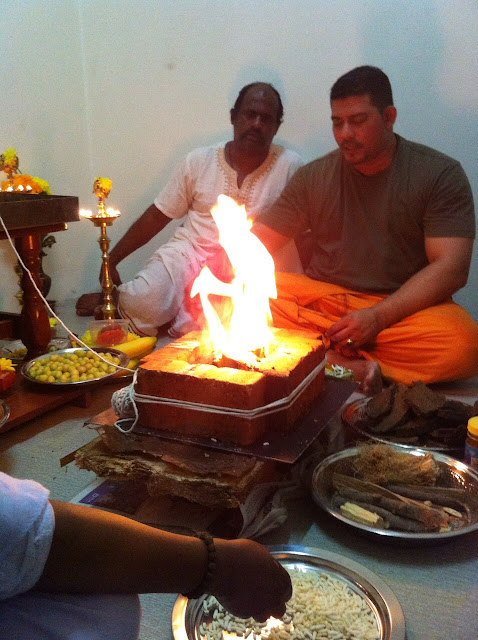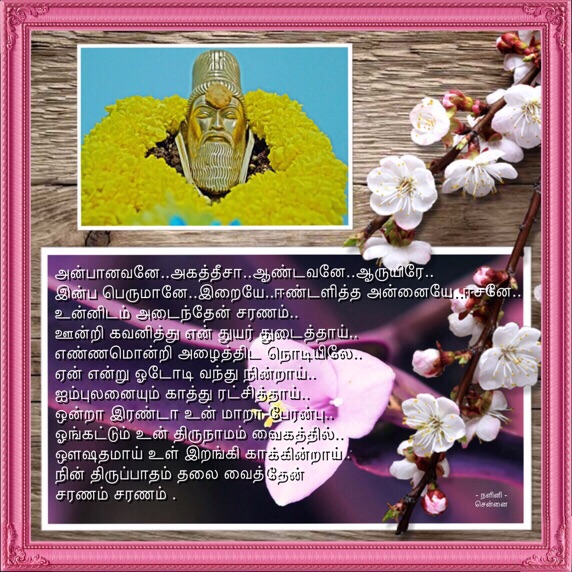Ramalinga Adigal's Nadesar Kummi is set to the tempo of the traditional folk tune and dance.
105. நடேசர் கொம்மி
1. கொம்மிய டிப்பெண்கள் கொம்மி யடி - இரு
கொங்கைகு லுங்கவே கொம்மி யடி.
2. நம்மை யாளும்பொன் னம்பல வாணனை
நாடிக் கொம்மிய டியுங்க டி - பதம்
பாடிக் கொம்மிய டியுங்க டி. - கொம்மி
3. காம மகற்றிய தூய னடி - சிவ
காம சவுந்தரி நேய னடி
மாமறை யோதுசெவ் வாய னடி - மணி
மன்றெனு ஞானவா காய னடி. - கொம்மி
4. ஆனந்தத் தாண்டவ ராஜ னடி - நமை
ஆட்கொண் டருளிய தேஜ னடி
வானந்த மாமலை மங்கை மகிழ் - வடி
வாளன டிமண வாள னடி. - கொம்மி
5. கல்லைக் கனிவிக்குஞ் சுத்த னடி - முடி
கங்கைக் கருளிய கர்த்த னடி
தில்லைச்சி தம்பர சித்த னடி - தேவ
சிங்கம டியுயர் தங்க மடி. - கொம்மி
6. பெண்ணொரு பால்வைத்த மத்த னடி - சிறு
பிள்ளைக் கறிகொண்ட பித்த னடி
நண்ணி நமக்கரு ளத்த னடி - மிக
நல்லன டியெல்லாம் வல்ல னடி.. - கொம்மி
7. அம்பலத் தாடல்செய் ஐய னடி - அன்பர்
அன்புக் கெளிதரு மெய்ய னடி
தும்பை முடிக்கணி தூய னடி - சுயஞ்
சோதிய டிபரஞ் சோதி யடி. - கொம்மி
8. கொம்மிய டிப்பெண்கள் கொம்மி யடி - இரு
கொங்கைகு லுங்கவே கொம்மி யடி.
105. n-ateesar kommi
1. kommiya tippeNkaL kommi yati - iru
kongkaiku lungkavee kommi yati.
2. n-ammai yaaLumpon nampala vaaNanai
n-aatik kommiya tiyungka ti - patham
paatik kommiya tiyungka ti. - kommi
3. kaama makaRRiya thuuya nati - siva
kaama savunthari n-eeya nati
maamaRai yoothusev vaaya nati - maNi
manRenu njaanavaa kaaya nati. - kommi
4. aananthath thaaNtava raaja nati - n-amai
aatkoN taruLiya theeja nati
vaanantha maamalai mangkai makiz - vati
vaaLana timaNa vaaLa nati. - kommi
5. kallaik kanivikkunj suththa nati - muti
kangkaik karuLiya karththa nati
thillaissi thampara siththa nati - theeva
singkama tiyuyar thangka mati. - kommi
6. peNNoru paalvaiththa maththa nati - siRu
piLLaik kaRikoNta piththa nati
n-aNNi n-amakkaru Laththa nati - mika
n-allana tiyellaam valla nati.. - kommi
7. ampalath thaatalsey aiya nati - anpar
anpuk keLitharu meyya nati
thumpai mutikkaNi thuuya nati - suyanj
soothiya tiparanj soothi yati. - kommi
8. kommiya tippeNkaL kommi yati - iru
kongkaiku lungkavee kommi yati.
Another song of Ramalinga Adigal that blends with the folk dance of India is Shanmugar Kummi.
055. சண்முகர் கொம்மி
055. சண்முகர் கொம்மி
1. குறவர் குடிசை நுழைந்தாண்டி - அந்தக்
கோமாட்டி எச்சில் விழைந்தாண்டி
துறவர் வணங்கும் புகழாண்டி - அவன்
தோற்றத்தைப் பாடி அடியுங்கடி.
2. மாமயில் ஏறி வருவாண்டி - அன்பர்
வாழ்த்த வரங்கள் தருவாண்டி
தீமையி லாத புகழாண்டி - அவன்
சீர்த்தியைப் பாடி அடியுங்கடி.
3. பன்னிரு தோள்கள் உடையாண்டி - கொடும்
பாவிகள் தம்மை அடையாண்டி
என்னிரு கண்கள் அனையாண்டி - அவன்
ஏற்றத்தைப் பாடி அடியுங்கடி.
4. வேங்கை மரமாகி நின்றாண்டி - வந்த
வேடர் தமைஎலாம் வென்றாண்டி
தீங்குசெய் சூரனைக் கொன்றாண்டி - அந்தத்
தீரனைப் பாடி அடியுங்கடி.
5. சீர்திகழ் தோகை மயில்மேலே - இளஞ்
செஞ்சுடர் தோன்றுந் திறம்போலே
கூர்வடி வேல்கொண்டு நம்பெருமான் - வருங்
கோலத்தைப் பாருங்கள் கோதையர்காள்.
6. ஆறு முகங்களில் புன்சிரிப்பும் - இரண்
டாறு புயந்திகழ் அற்புதமும்
வீறு பரஞ்சுடர் வண்ணமும்ஓர் - திரு
மேனியும் பாருங்கள் வெள்வளைகாள்.
7. ஆனந்த மான அமுதனடி - பர
மானந்த நாட்டுக் கரசனடி
தானந்த மில்லாச் சதுரனடி - சிவ
சண்முகன் நங்குரு சாமியடி.
8. வேதமுடி சொல்லும் நாதனடி - சதுர்
வேதமு டிதிகழ் பாதனடி
நாத வடிவுகொள் நீதனடி - பர
நாதங் கடந்த நலத்தனடி.
9. தத்துவத் துள்ளே அடங்காண்டி - பர
தத்துவம் அன்றித் துடங்காண்டி
சத்துவ ஞான வடிவாண்டி - சிவ
சண்முக நாதனைப் பாடுங்கடி.
10. சச்சிதா னந்த உருவாண்டி - பர
தற்பர போகந் தருவாண்டி
உச்சிதாழ் அன்பர்க் குறவாண்டி - அந்த
உத்தம தேவனைப் பாடுங்கடி.
11. அற்புத மான அழகனடி - துதி
அன்பர்க் கருள்செய் குழகனடி
சிற்பர யோகத் திறத்தனடி-அந்தச்
சேவகன் சீர்த்தியைப் பாடுங்கடி.
12. சைவந் தழைக்கத் தழைத்தாண்டி -ஞான
சம்பந்தப் பேர்கொண் டழைத்தாண்டி
பொய்வந்த உள்ளத்தில் போகாண்டி - அந்தப்
புண்ணியன் பொன்னடி போற்றுங்கடி.
13. வாசி நடத்தித் தருவாண்டி - ஒரு
வாசியில் இங்கே வருவாண்டி
ஆசில் கருணை உருவாண்டி - அவன்
அற்புதத் தாள்மலர் ஏத்துங்கடி.
14. இராப்பகல் இல்லா இடத்தாண்டி - அன்பர்
இன்ப உளங்கொள் நடத்தாண்டி
அராப்பளி ஈந்த திடத்தாண்டி - அந்த
அண்ணலைப் பாடி அடியுங்கடி.
15. ஒன்றிரண் டான உளவாண்டி - அந்த
ஒன்றிரண் டாகா அளவாண்டி
மின்திரண் டன்ன வடிவாண்டி - அந்த
மேலவன் சீர்த்தியைப் பாடுங்கடி.
055. saNmukar kommi
1. kuRavar kutisai n-uzainthaaNti - anthak
koomaatti essil vizainthaaNti
thuRavar vaNangkum pukazaaNti - avan
thooRRaththaip paati atiyungkati.
2. maamayil eeRi varuvaaNti - anpar
vaazththa varangkaL tharuvaaNti
thiimaiyi laatha pukazaaNti - avan
siirththiyaip paati atiyungkati.
3. panniru thooLkaL utaiyaaNti - kotum
paavikaL thammai ataiyaaNti
enniru kaNkaL anaiyaaNti - avan
eeRRaththaip paati atiyungkati.
4. veengkai maramaaki n-inRaaNti - vantha
veetar thamaielaam venRaaNti
thiingkusey suuranaik konRaaNti - anthath
thiiranaip paati atiyungkati.
5. siirthikaz thookai mayilmeelee - iLanj
senjsutar thoonRun- thiRampoolee
kuurvati veelkoNtu n-amperumaan - varung
koolaththaip paarungkaL koothaiyarkaaL.
6. aaRu mukangkaLil punsirippum - iraN
taaRu puyanthikaz aRputhamum
viiRu paranjsutar vaNNamumoor - thiru
meeniyum paarungkaL veLvaLaikaaL.
7. aanantha maana amuthanati - para
maanantha n-aattuk karasanati
thaanantha millaas sathuranati - siva
saNmukan n-angkuru saamiyati.
8. veethamuti sollum n-aathanati - sathur
veethamu tithikaz paathanati
n-aatha vativukoL n-iithanati - para
n-aathang katantha n-alaththanati.
9. thaththuvath thuLLee atangkaaNti - para
thaththuvam anRith thutangkaaNti
saththuva njaana vativaaNti - siva
saNmuka n-aathanaip paatungkati.
10. sassithaa nantha uruvaaNti - para
thaRpara pookan- tharuvaaNti
ussithaaz anpark kuRavaaNti - antha
uththama theevanaip paatungkati.
11. aRputha maana azakanati - thuthi
anpark karuLsey kuzakanati
siRpara yookath thiRaththanati-anthas
seevakan siirththiyaip paatungkati.
12. saivan- thazaikkath thazaiththaaNti -njaana
sampanthap peerkoN tazaiththaaNti
poyvantha uLLaththil pookaaNti - anthap
puNNiyan ponnati pooRRungkati.
13. vaasi n-ataththith tharuvaaNti - oru
vaasiyil ingkee varuvaaNti
aasil karuNai uruvaaNti - avan
aRputhath thaaLmalar eeththungkati.
14. iraappakal illaa itaththaaNti - anpar
inpa uLangkoL n-ataththaaNti
araappaLi iintha thitaththaaNti - antha
aNNalaip paati atiyungkati.
15. onRiraN taana uLavaaNti - antha
onRiraN taakaa aLavaaNti
minthiraN tanna vativaaNti - antha
meelavan siirththiyaip paatungkati.
According to wikipedia.org, in Kummi, the dancers gather in a circle and clap their hands as they dance while the Kolattam, an extension to this, is "where instead of clapping, the participants hold small wooden rods in their hands and strike these in rhythm as they dance."
From http://beautyspotsofindia.com/kummi-dance/, "the word ‘Kummi’ literally means dancing with clapping of hands to time and singing poems. Since the dance has originated without accompaniment of any musical beats, the dancers clap their hands to keep time." It also mentions that "Subramania Bharathiyar, a famous Tamil poet and social reformer who wrote Kummi Pattu employed the folk dance Kummi."










